Related Research Articles
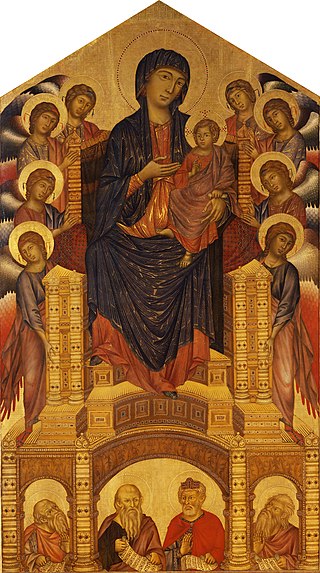
Giovanni Cimabue, c. 1240 – 1302, was an Italian painter and designer of mosaics from Florence. He was also known as Cenni di Pepo or Cenni di Pepi.
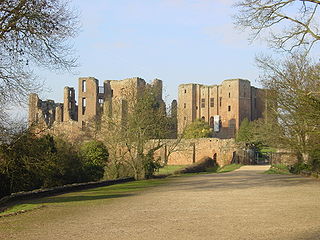
The Dictum of Kenilworth, issued on 31 October 1266, was a pronouncement designed to reconcile the rebels of the Second Barons' War with the royal government of England. After the baronial victory at the Battle of Lewes in 1264, Simon de Montfort took control of royal government, but at the Battle of Evesham the next year Montfort was killed, and King Henry III restored to power. A group of rebels held out in the stronghold of Kenilworth Castle, however, and their resistance proved difficult to crush.

Pope Clement IV, born Gui Foucois and also known as Guy le Gros, was bishop of Le Puy (1257–1260), archbishop of Narbonne (1259–1261), cardinal of Sabina (1261–1265), and head of the Catholic Church from 5 February 1265 until his death. His election as pope occurred at a conclave held at Perugia that lasted four months while cardinals argued over whether to call in Charles I of Anjou, the youngest brother of Louis IX of France, to carry on the papal war against the Hohenstaufens. Pope Clement was a patron of Thomas Aquinas and of Roger Bacon, encouraging Bacon in the writing of his Opus Majus, which included important treatises on optics and the scientific method.

Roger Bacon, also known by the scholastic accolade Doctor Mirabilis, was a polymath, a medieval English philosopher, scientist, theologian and Franciscan friar who placed considerable emphasis on the study of nature through empiricism. Intertwining his Catholic faith with scientific thinking, Roger Bacon is considered one of the greatest polymaths of the medieval period.
The 1260s is the decade starting January 1, 1260 and ending December 31, 1269.
Year 1177 (MCLXXVII) was a common year starting on Saturday of the Julian calendar.

Year 1241 (MCCXLI) was a common year starting on Tuesday of the Julian calendar.

Year 1260 (MCCLX) was a leap year starting on Thursday of the Julian calendar.

Year 1265 (MCCLXV) was a common year starting on Thursday of the Julian calendar.

The Eighth Crusade was the second Crusade launched by Louis IX of France, this one against the Hafsid dynasty in Tunisia in 1270. It is also known as the Crusade of Louis IX Against Tunis or the Second Crusade of Louis. The Crusade did not see any significant fighting as Louis died of dysentery shortly after arriving on the shores of Tunisia. The Treaty of Tunis was negotiated between the Crusaders and the Hafsids. No changes in territory occurred, though there were commercial and some political rights granted to the Christians. The Crusaders withdrew back to Europe soon after.
Robert Burnell was an English bishop who served as Lord Chancellor of England from 1274 to 1292. A native of Shropshire, he served as a minor royal official before entering into the service of Prince Edward, the future King Edward I of England. When Edward went on the Eighth Crusade in 1270, Burnell stayed in England to secure the prince's interests. He served as regent after the death of King Henry III of England while Edward was still on crusade. He was twice elected Archbishop of Canterbury, but his personal life—which included a long-term mistress who was rumoured to have borne him four sons—prevented his confirmation by the papacy. In 1275 Burnell was elected Bishop of Bath and Wells, after Edward had appointed him Lord Chancellor in 1274.

Thomas Arundel was an English clergyman who served as Lord Chancellor and Archbishop of York during the reign of Richard II, as well as Archbishop of Canterbury in 1397 and from 1399 until his death, an outspoken opponent of the Lollards. He was instrumental in the usurpation of Richard by his cousin Henry Bolingbroke, who became Henry IV.

The Lord Warden of the Cinque Ports is a ceremonial official in the United Kingdom. The post dates from at least the 12th century, when the title was Keeper of the Coast, but may be older. The Lord Warden was originally in charge of the Cinque Ports, a group of five port towns on the southeast coast of England that was formed to collectively supply ships for The Crown in the absence at the time of a formal navy. Today the role is a sinecure and an honorary title, and fourteen towns belong to the Cinque Ports confederation. The title is one of the higher honours bestowed by the Sovereign; it has often been held by members of the Royal Family or prime ministers, especially those who have been influential in defending Britain at times of war.
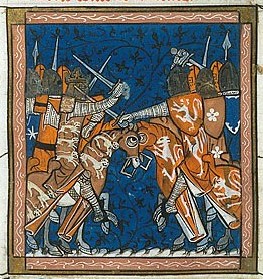
The Second Barons' War (1264–1267) was a civil war in England between the forces of barons led by Simon de Montfort against the royalist forces of King Henry III, led initially by the king himself and later by his son, the future King Edward I. The barons sought to force the king to rule with a council of barons, rather than through his favourites. The war also involved a series of massacres of Jews by de Montfort's supporters, including his sons Henry and Simon, in attacks aimed at seizing and destroying evidence of baronial debts. To bolster the initial success of his baronial regime, de Montfort sought to broaden the social foundations of parliament by extending the franchise to the commons for the first time. However, after a rule of just over a year, de Montfort was killed by forces loyal to the king at the Battle of Evesham.
Walter Giffard was Lord Chancellor of England and Archbishop of York.

Antony Bek was a bishop of Durham and the Patriarch of Jerusalem.

Constance II was Queen of Sicily from September 1282 to November 1285 alongside her husband, King Peter I. She was also Queen of Aragon from 1276 to 1285 during her husband's reign as Peter III of Aragon. She was a pretender to the Kingdom of Sicily from 1268 to 1282. She was the only daughter of Manfred, King of Sicily, and his first wife, Beatrice of Savoy.
Events from the 1260s in England.
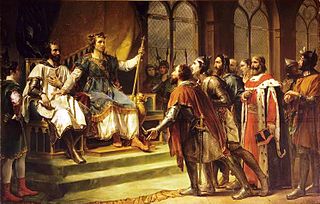
The Mise of Amiens was a settlement given by King Louis IX of France on 23 January 1264 in the conflict between King Henry III of England and his rebellious barons, led by Simon de Montfort. Louis' one-sided decision for King Henry led directly to the hostilities of the Second Barons' War.
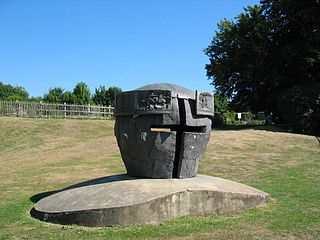
The Mise[a]of Lewes was a settlement made on 14 May 1264 between King Henry III of England and his rebellious barons, led by Simon de Montfort. The settlement was made on the day of the Battle of Lewes, one of the two major battles of the Second Barons' War. The conflict between king and magnates was caused by dissatisfaction with the influence of foreigners at court and Henry's high level and new methods of taxation. In 1258, Henry had been forced to accept the Provisions of Oxford, which essentially left the royal government in the hands of a council of magnates, but this document went through a long series of revocations and reinstatements. In 1263, as the country was on the brink of civil war, the two parties had agreed to submit the matter to arbitration by the French king Louis IX. Louis was a firm believer in the royal prerogative, and decided clearly in favour of Henry. The outcome was unacceptable for the rebellious barons, and war between the two parties broke out almost immediately.
References
- ↑ Symons, Van Jay (2013). Friedman, John Block; Figg, Kristen Mossler (eds.). Trade, Travel, and Exploration in the Middle Ages: An Encyclopedia. New York and London: Routledge. pp. 319–320. ISBN 9781135590949.
- ↑ Iqbal, Muzaffar (2007). Science and Islam. Westport, CN and London: Greenwood Publishing Group. pp. xxxi. ISBN 9780313335761.
- ↑ Melton, J. Gordon (2014). Faiths Across Time: 5,000 Years of Religious History. Vol. II: 500 - 1399 CE. Santa Barbara, CA, Denver, CO and Oxford: ABC-CLIO. p. 855. ISBN 9781610690263.
- ↑ Stanislawski, Dan (2015) [1959]. The Individuality of Portugal: A Study in Historical-Political Geography. Austin, TX: University of Texas Press. p. 213. ISBN 9781477305072.
- ↑ Nicol, Donald M. (2010) [1984]. The Despotate of Epiros 1267-1479: A Contribution to the History of Greece in the Middle Ages. Cambridge, London and New York: Cambridge University Press. p. 12. ISBN 9780521261906.
- ↑ Sadler, John (2008). The Second Barons' War: Simon de Montfort and the Battles of Lewes and Evesham. Barnsley, UK: Casemate Publishers. pp. 118–119. ISBN 9781844158317.
- ↑ Santiuste, David (2015). The Hammer of the Scots: Edward I and the Scottish Wars of Independence. Barnsley, UK: Pen and Sword. ISBN 9781473857650.
- ↑ Nedvěd, Martin; Peřinková, Martina (2017). "The City of Ostrava (Czech Republic): a Sustainability Assessment Based on Vitality". In Brebbia, C. A.; Sendra, J. J. (eds.). The Sustainable City XII. Southampton and Boston: Wessex Institute of Technology Press. p. 15. ISBN 9781784662172.
- ↑ Bruin, Tom de (2014). The Great Controversy: The Individual's Struggle Between Good and Evil in the Testaments of the Twelve Patriarchs and in Their Jewish and Christian Contexts. Göttingen, Germany: Vandenhoeck & Ruprecht. p. 14. ISBN 9783525540350.
- ↑ Clegg, Brian (2016). Are Numbers Real?: The Uncanny Relationship of Mathematics and the Physical World. New York: St. Martin's Press. p. 80. ISBN 9781466892965.
- ↑ Newall, Venetia (2013). The Witch Figure: Folklore Essays by a Group of Scholars in England Honouring the 75th Birthday of Katharine M. Briggs. Anthropology and Ethnography. London and New York: Routledge. p. 108. ISBN 9781136551734.
- ↑ Brand, Paul (2003). Kings, Barons and Justices: The Making and Enforcement of Legislation in Thirteenth-Century England. Cambridge and New York: Cambridge University Press. p. 1. ISBN 9781139439077.
- ↑ Streitz, N.; Rizk, A.; Andre, J.; André, J. (1990). "Links and Structures in Hypertext Databases for Law". Hypertext: Concepts, Systems and Applications: Proceedings of the First European Conference on Hypertext, INRIA, France, November 1990. Cambridge and New York: Cambridge University Press. p. 194. ISBN 9780521405171.
- ↑ Gemmill, Elizabeth (2013). The Nobility and Ecclesiastical Patronage in Thirteenth-Century England. Woodbridge, UK: Boydell Press. p. 8. ISBN 9781843838128.
- ↑ Jaspert, Nikolas (2019). Queens, Princesses and Mendicants: Close Relations in a European Perspective. Vita Regularis - Ordnungen und Deutungen religiosen Lebens im Mittelalter. Zürich, Switzerland: LIT Verlag Münster. p. 20. ISBN 9783643910929.
- ↑ Thompson, Bard (1996). "10. Painters and Sculptors of the Quattrocento - Giotto and his Times". Humanists and Reformers: A History of the Renaissance and Reformation . Grand Rapids, MI and Cambridge, UK: Wm. B. Eerdmans Publishing. pp. 229. ISBN 9780802863485.
1267 Giotto.
- ↑ Guise, Richard (2011). Two Wheels Over Catalonia: Cycling the Back Roads of North-Eastern Spain. Chichester, UK: Summersdale Publishers Limited. p. 310. ISBN 9780857652850.
- ↑ Marcos Hierro, Ernest (2010). Rogers, Clifford J. (ed.). The Oxford Encyclopedia of Medieval Warfare and Military Technology. Vol. I: Aachen, Siege of - Dyrrachium, Siege and Battle of (1081). Oxford and New York: Oxford University Press. p. 52. ISBN 9780195334036.
- ↑ Shirley, Janet (2016) [1999]. Crusader Syria in the Thirteenth Century: The Rothelin Continuation of the History of William of Tyre with Part of the Eracles or Acre Text. Oxford and New York: Routledge. ISBN 9781351947114.
- ↑ Thomson, Williell R. (1975). Friars in the Cathedral: The First Franciscan Bishops 1226-1261. Toronto: Pontifical Institute of Mediaeval Studies. p. 67. ISBN 9780888440334.
- ↑ Wispelwey, Berend (2011). Biographical Index of the Middle Ages. Munich, Germany: K. G. Saur Verlag. p. 877. ISBN 9783110914160.
- ↑ Jackson, Guida M.; Jackson-Laufer, Guida Myrl (1999). Women Rulers Throughout the Ages: An Illustrated Guide . Santa Barbara, CA, Denver CO and Oxford, UK: ABC-CLIO. pp. 52. ISBN 9781576070918.
1267 Beatrice of provence.
- ↑ José García Oro, "Pedro González Pérez", Diccionario Biográfico electrónico (Real Academia de la Historia, 2018), retrieved 9 October 2020.
- ↑ Watkins, Basil (2015) [2002]. The Book of Saints: A Comprehensive Biographical Dictionary. London: Bloomsbury Publishing. ISBN 9780567664150.
- ↑ Hone, William (1830). The Every-day Book and Table Book: Or, Everlasting Calendar of Popular Amusements, Sports, Pastimes, Ceremonies, Manners, Customs, and Events, Incident to Each of the Three Hundred and Sixty-five Days, in Past and Present Times; Forming a Complete History of the Year, Months, and Seasons, and a Perpetual Key to the Almanac ... for Daily Use and Diversio. London: J. Haddon. p. 1509.
- ↑ Edbury, Peter W. (1994) [1991]. The Kingdom of Cyprus and the Crusades, 1191-1374. Cambridge and New York: Cambridge University Press. p. 35. ISBN 9780521458375.
- ↑ Horsfield, Thomas Walker (1835). The History, Antiquities, and Topography of the County of Sussex. Sussex and London: Sussex Press, Baxter. p. 3.